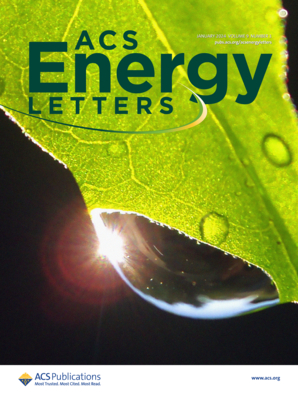Lattice-Matched Ta3N5/Nb5N6 Interface Enables a Bulk Charge Separation Efficiency of Close to 100%
IF 19.3
1区 材料科学
Q1 CHEMISTRY, PHYSICAL
引用次数: 0
Abstract
The interface between the semiconductor light absorber and the metal electrode is critical for facilitating the extraction of photogenerated charges in photoelectrodes. Achieving a lattice-matched semiconductor/electrode interface with low defect density is highly desirable but remains a challenge for Ta3N5 photoanodes. In this study, we synthesized niobium nitride thin film electrodes with controllable crystallographic phases to achieve a lattice-matched Ta3N5/Nb5N6 back contact. This results in an enhanced crystallinity of the Ta3N5 film and reduced interfacial defect density. Consequently, the photoanode with the lattice-matched back contact attains a record half-cell solar-to-hydrogen conversion efficiency of 4.1%, attributed to the bulk carrier separation efficiency of nearly 100%. This work highlights lattice-matching as an effective strategy to enhance the efficiency of thin film-based solar energy conversion devices.

晶格匹配的Ta3N5/Nb5N6接口使大量电荷分离效率接近100%
半导体光吸收剂与金属电极之间的界面对于促进光电极中光生电荷的提取至关重要。实现具有低缺陷密度的晶格匹配半导体/电极界面是非常理想的,但对于Ta3N5光阳极来说仍然是一个挑战。在这项研究中,我们合成了具有可控晶相的氮化铌薄膜电极,以实现晶格匹配的Ta3N5/Nb5N6背接触。这提高了Ta3N5薄膜的结晶度,降低了界面缺陷密度。因此,具有晶格匹配背接触的光阳极实现了创纪录的半电池太阳能到氢的转换效率,达到4.1%,这归功于近100%的散装载体分离效率。这项工作强调了晶格匹配是提高薄膜太阳能转换装置效率的有效策略。
本文章由计算机程序翻译,如有差异,请以英文原文为准。
求助全文
约1分钟内获得全文
求助全文
来源期刊

ACS Energy Letters
Energy-Renewable Energy, Sustainability and the Environment
CiteScore
31.20
自引率
5.00%
发文量
469
审稿时长
1 months
期刊介绍:
ACS Energy Letters is a monthly journal that publishes papers reporting new scientific advances in energy research. The journal focuses on topics that are of interest to scientists working in the fundamental and applied sciences. Rapid publication is a central criterion for acceptance, and the journal is known for its quick publication times, with an average of 4-6 weeks from submission to web publication in As Soon As Publishable format.
ACS Energy Letters is ranked as the number one journal in the Web of Science Electrochemistry category. It also ranks within the top 10 journals for Physical Chemistry, Energy & Fuels, and Nanoscience & Nanotechnology.
The journal offers several types of articles, including Letters, Energy Express, Perspectives, Reviews, Editorials, Viewpoints and Energy Focus. Additionally, authors have the option to submit videos that summarize or support the information presented in a Perspective or Review article, which can be highlighted on the journal's website. ACS Energy Letters is abstracted and indexed in Chemical Abstracts Service/SciFinder, EBSCO-summon, PubMed, Web of Science, Scopus and Portico.
 求助内容:
求助内容: 应助结果提醒方式:
应助结果提醒方式:


